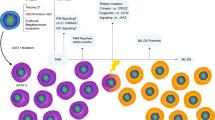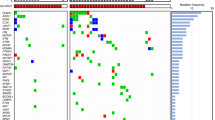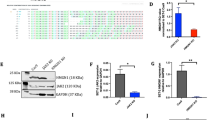Abstract
Acute megakaryoblastic leukemia (AMKL) is a subtype of acute myeloid leukemia (AML) in which cells morphologically resemble abnormal megakaryoblasts. While rare in adults, AMKL accounts for 4–15% of newly diagnosed childhood AML cases1,2,3. AMKL in individuals without Down syndrome (non-DS-AMKL) is frequently associated with poor clinical outcomes. Previous efforts have identified chimeric oncogenes in a substantial number of non-DS-AMKL cases, including RBM15-MKL1, CBFA2T3-GLIS2, KMT2A gene rearrangements, and NUP98-KDM5A4,5,6. However, the etiology of 30–40% of cases remains unknown. To better understand the genomic landscape of non-DS-AMKL, we performed RNA and exome sequencing on specimens from 99 patients (75 pediatric and 24 adult). We demonstrate that pediatric non-DS-AMKL is a heterogeneous malignancy that can be divided into seven subgroups with varying outcomes. These subgroups are characterized by chimeric oncogenes with cooperating mutations in epigenetic and kinase signaling genes. Overall, these data shed light on the etiology of AMKL and provide useful information for the tailoring of treatment.
This is a preview of subscription content, access via your institution
Access options
Access Nature and 54 other Nature Portfolio journals
Get Nature+, our best-value online-access subscription
$29.99 / 30 days
cancel any time
Subscribe to this journal
Receive 12 print issues and online access
$209.00 per year
only $17.42 per issue
Buy this article
- Purchase on Springer Link
- Instant access to full article PDF
Prices may be subject to local taxes which are calculated during checkout




Similar content being viewed by others
References
Pagano, L. et al. Acute megakaryoblastic leukemia: experience of GIMEMA trials. Leukemia 16, 1622–1626 (2002).
Athale, U.H. et al. Biology and outcome of childhood acute megakaryoblastic leukemia: a single institution's experience. Blood 97, 3727–3732 (2001).
Barnard, D.R., Alonzo, T.A., Gerbing, R.B., Lange, B. & Woods, W.G. Comparison of childhood myelodysplastic syndrome, AML FAB M6 or M7, CCG 2891: report from the Children's Oncology Group. Pediatr. Blood Cancer 49, 17–22 (2007).
Ma, Z. et al. Fusion of two novel genes, RBM15 and MKL1, in the t(1;22)(p13;q13) of acute megakaryoblastic leukemia. Nat. Genet. 28, 220–221 (2001).
Gruber, T.A. et al. An Inv(16)(p13.3q24.3)-encoded CBFA2T3-GLIS2 fusion protein defines an aggressive subtype of pediatric acute megakaryoblastic leukemia. Cancer Cell 22, 683–697 (2012).
de Rooij, J.D. et al. NUP98/JARID1A is a novel recurrent abnormality in pediatric acute megakaryoblastic leukemia with a distinct HOX gene expression pattern. Leukemia 27, 2280–2288 (2013).
Baruchel, A., Daniel, M.T., Schaison, G. & Berger, R. Nonrandom t(1;22)(p12-p13;q13) in acute megakaryocytic malignant proliferation. Cancer Genet. Cytogenet. 54, 239–243 (1991).
Mercher, T. et al. Involvement of a human gene related to the Drosophila spen gene in the recurrent t(1;22) translocation of acute megakaryocytic leukemia. Proc. Natl. Acad. Sci. USA 98, 5776–5779 (2001).
Radtke, I. et al. Genomic analysis reveals few genetic alterations in pediatric acute myeloid leukemia. Proc. Natl. Acad. Sci. USA 106, 12944–12949 (2009).
Dorsam, S.T. et al. The transcriptome of the leukemogenic homeoprotein HOXA9 in human hematopoietic cells. Blood 103, 1676–1684 (2004).
Hu, Y.L., Passegué, E., Fong, S., Largman, C. & Lawrence, H.J. Evidence that the Pim1 kinase gene is a direct target of HOXA9. Blood 109, 4732–4738 (2007).
Kaushansky, K. et al. Promotion of megakaryocyte progenitor expansion and differentiation by the c-Mpl ligand thrombopoietin. Nature 369, 568–571 (1994).
Dastugue, N. et al. Cytogenetic profile of childhood and adult megakaryoblastic leukemia (M7): a study of the Groupe Français de Cytogénétique Hématologique (GFCH). Blood 100, 618–626 (2002).
Nimer, S.D., MacGrogan, D., Jhanwar, S. & Alvarez, S. Chromosome 19 abnormalities are commonly seen in AML, M7. Blood 100, 3838 author reply 3838–3839 (2002).
Reinhardt, D. et al. GATA1-mutation associated leukemia in children with trisomy 21 mosaic. Klin. Padiatr. 224, 153–155 (2012).
Loughran, S.J. et al. The transcription factor Erg is essential for definitive hematopoiesis and the function of adult hematopoietic stem cells. Nat. Immunol. 9, 810–819 (2008).
Goyama, S. et al. UBASH3B/Sts-1-CBL axis regulates myeloid proliferation in human preleukemia induced by AML1-ETO. Leukemia 30, 728–739 (2016).
Emmrich, S. et al. LincRNAs MONC and MIR100HG act as oncogenes in acute megakaryoblastic leukemia. Mol. Cancer 13, 171 (2014).
Malinge, S. et al. Increased dosage of the chromosome 21 ortholog Dyrk1a promotes megakaryoblastic leukemia in a murine model of Down syndrome. J. Clin. Invest. 122, 948–962 (2012).
Salek-Ardakani, S. et al. ERG is a megakaryocytic oncogene. Cancer Res. 69, 4665–4673 (2009).
Goeman, J.J., van de Geer, S.A., de Kort, F. & van Houwelingen, H.C. A global test for groups of genes: testing association with a clinical outcome. Bioinformatics 20, 93–99 (2004).
Andersson, A.K. et al. The landscape of somatic mutations in infant MLL-rearranged acute lymphoblastic leukemias. Nat. Genet. 47, 330–337 (2015).
Yoshida, K. et al. The landscape of somatic mutations in Down syndrome–related myeloid disorders. Nat. Genet. 45, 1293–1299 (2013).
Creutzig, U. et al. AML patients with Down syndrome have a high cure rate with AML-BFM therapy with reduced dose intensity. Leukemia 19, 1355–1360 (2005).
Inaba, H. et al. Heterogeneous cytogenetic subgroups and outcomes in childhood acute megakaryoblastic leukemia: a retrospective international study. Blood 126, 1575–1584 (2015).
Schweitzer, J. et al. Improved outcome of pediatric patients with acute megakaryoblastic leukemia in the AML-BFM 04 trial. Ann. Hematol. 94, 1327–1336 (2015).
Kudo, K. et al. Mosaic Down syndrome–associated acute myeloid leukemia does not require high-dose cytarabine treatment for induction and consolidation therapy. Int. J. Hematol. 91, 630–635 (2010).
Zhang, J. et al. The genetic basis of early T-cell precursor acute lymphoblastic leukaemia. Nature 481, 157–163 (2012).
Trapnell, C. et al. Differential analysis of gene regulation at transcript resolution with RNA–seq. Nat. Biotechnol. 31, 46–53 (2013).
Trapnell, C. et al. Transcript assembly and quantification by RNA–Seq reveals unannotated transcripts and isoform switching during cell differentiation. Nat. Biotechnol. 28, 511–515 (2010).
Klusmann, J.H. et al. miR-125b-2 is a potential oncomiR on human chromosome 21 in megakaryoblastic leukemia. Genes Dev. 24, 478–490 (2010).
Robinson, M.D., McCarthy, D.J. & Smyth, G.K. edgeR: a Bioconductor package for differential expression analysis of digital gene expression data. Bioinformatics 26, 139–140 (2010).
Soneoka, Y. et al. A transient three-plasmid expression system for the production of high titer retroviral vectors. Nucleic Acids Res. 23, 628–633 (1995).
Mullighan, C.G. et al. Genome-wide analysis of genetic alterations in acute lymphoblastic leukaemia. Nature 446, 758–764 (2007).
Pounds, S. et al. Reference alignment of SNP microarray signals for copy number analysis of tumors. Bioinformatics 25, 315–321 (2009).
Lin, M. et al. dChipSNP: significance curve and clustering of SNP-array-based loss-of-heterozygosity data. Bioinformatics 20, 1233–1240 (2004).
Olshen, A.B., Venkatraman, E.S., Lucito, R. & Wigler, M. Circular binary segmentation for the analysis of array-based DNA copy number data. Biostatistics 5, 557–572 (2004).
McCarroll, S.A. et al. Integrated detection and population-genetic analysis of SNPs and copy number variation. Nat. Genet. 40, 1166–1174 (2008).
Iafrate, A.J. et al. Detection of large-scale variation in the human genome. Nat. Genet. 36, 949–951 (2004).
Li, H. et al. The Sequence Alignment/Map format and SAMtools. Bioinformatics 25, 2078–2079 (2009).
Koboldt, D.C. et al. VarScan 2: somatic mutation and copy number alteration discovery in cancer by exome sequencing. Genome Res. 22, 568–576 (2012).
Acknowledgements
We thank all the patients and their parents who allowed their leukemic samples to be stored and studied. We thank the Tissue Resources Laboratory, the Flow Cytometry and Cell Sorting Core, and the Clinical Applications of Core Technology Laboratories of the Hartwell Center for Bioinformatics and Biotechnology of St. Jude Children's Research Hospital. J.D.E.d.R. was funded by Stichting Kinderoncologisch Centrum Rotterdam (KOCR). A.O. and L.J.V. were funded by KIKA (Children Cancer-Free Foundation). M.F. was supported by the Dutch Cancer Society (KWF). F.L. was supported by the Italian Association for Research on Cancer (Associazione Italiana Ricerca sul Cancro; Special Grant “5xmille”-9962). This work was funded by the St. Jude Children's Research Hospital–Washington University Pediatric Cancer Genome Project, the American Lebanese and Syrian Associated Charities of St. Jude Children's Research Hospital, and the Eric Trump Foundation.
Author information
Authors and Affiliations
Contributions
T.A.G. and M.F. designed all experiments. J.C., H.L.M., and J.E. constructed libraries and sequenced samples. J.M. led the sequencing analysis. J.M., Y.L., M.P.W., M.R., G.S., A.O., M.F., M.E., P.G., and J.Z. performed computational data analyses. J.D.E.d.R., C.B., and L.J.V. performed validation experiments. C.B., J.M., and T.A.G. manually filtered SNV and indel calls on unpaired samples. C.K. and J.D. performed functional work on the HOX fusions. J.D.E.d.R., M.Z., and M.F. performed outcome analysis. J.Y.S.L., K.R., M.P., A.E.J.Y., L.-Y.S., D.-C.L., S.H., D.S.K., F.L., D.R., M.M.v.d.H.-E., C.M.Z., and T.A.G. provided annotated patient samples. J.D.E.d.R., C.B., J.R.D., F.L., D.R., M.M.v.d.H.-E., and C.M.Z. performed critical reading and contributed to the writing of the manuscript. M.F. and T.A.G. wrote the manuscript.
Corresponding authors
Ethics declarations
Competing interests
The authors declare no competing financial interests.
Integrated supplementary information
Supplementary Figure 1 HOX fusions enhance self-renewal capacity.
Mouse bone marrow was transduced with a retrovirus carrying one of three HOX fusion genes or the empty mCherry reporter construct as described in Online Methods. (a) At 1-week intervals, colonies were counted and cells were replated in duplicate for a total of four platings. Each bar donates colony counts for a replating round. Error bars indicate standard error of the mean. Data are compiled from two separate experiments with similar results. (b) Flow cytometry of colonies. Data shown are from one of two experiments with similar results.
Supplementary Figure 2 HOX rearranged subgroup gene expression signatures.
(a) HOX fusion partner genes are upregulated in HOX rearranged cases. Relative HOX gene expression values (row percentiles) are indicated by heat color (color key). Genes are ordered by chromosomal position. Arrows indicate direction of transcription of protein-coding HOX genes. Fusion genes are divided by coding (top) and non-coding HOX fusions and ordered by HOX fusion partner. Right column summarizes the expression value of the HOX gene involved in the rearrangement. (b) HOXA9 target genes are upregulated in the HOX rearranged subgroup. Distribution of expression of genes within the HOXA9 target upregulated gene set showing the highest association with AMKL subgroup10. Expression is highest in the HOX rearranged cases for both protein coding and non-protein coding HOX fusions (red circles).
Supplementary Figure 3 Genomic driver mutations in adult AMKL.
Recurrently mutated genes in the adult cohort as determined by whole exome sequencing, copy number alterations, and cytogenetics (see Supplementary Tables 7 and 8 for detailed information on each mutation).
Supplementary Figure 4 Genomic driver mutations in pediatric AMKL.
Recurrently mutated genes in the pediatric cohort as determined by whole exome sequencing, copy number alterations, and cytogenetics (see Supplementary Tables 6 and 8 for detailed information on each mutation).
Supplementary Figure 5 Down syndrome AML and chromosome 21 gene expression patterns.
(a) GATA1 mutant non-DS-AMKL and DS-AML gene expression patterns correlate. Scatterplots of relative gene expression values (log2 ratios) of differentially expressed genes in DS-AML compared to non-DS AML (y-axes) and those of the different non-DS AMKL subgroups relative to the other groups combined (x-axes). Spearman correlation coefficients of comparisons are shown to the right. (b) Chromosome 21 expression levels. Relative expression of genes on chromosome 21 in the AMKL subgroups is shown. Genomic amplification status for each sample is indicated by the circles. Filled circles, amplified chromosome 21; open circles, chromosome 21 status not analyzed/unknown.
Supplementary Figure 6 RB1 expression levels.
RB1 expression levels as determined by RNA-seq are shown for NUP98-KDM5A specimens vs. others.
Supplementary Figure 7 Cooperation of MPL mutations and HOX rearrangements.
Murine bone marrow was co-transduced with a retrovirus carrying a HOX fusion gene and an MPL gene in the following combinations: mCherry (MIC)+GFP(MIG); MIC+MPL wild type (MPLwt); MIC+MPL S505N mutant (MPLS505N); MIC+MPL W515L mutant (MPLW515L); GATA2-HOXA9+MIG; GATA2-HOXA9+MPLwt; GATA2-HOXA9+MPLS505N; GATA2-HOXA9+MPLW515L; NIPBL-HOXB9+MIG; NIPBL-HOXB9+MPLwt; NIPBL-HOXB9+MPLS505N; NIPBL-HOXB9+MPLW515L. Double-positive transduced cells were flow sorted using mCherry and GFP markers. (a) MPL mutations do not enhance self-renewal. Sorted cells were grown on methylcellulose supplemented with cytokines. At 1-week intervals, colonies were counted and cells were replated for a total of three platings. Each bar donates colony counts for a replating round. Error bars indicate standard error of the mean. Data are compiled from two separate experiments with similar results. (b) MPL mutations enhance cytokine-independent growth. 5 x 105 cells from the third CFU plating were removed and placed in liquid culture in the absence of cytokines in triplicate. Viable cells were counted daily for one week. Error bars indicate standard error of the mean. Data shown are from one of two experiments with similar results.
Supplementary Figure 8 MPL mutations enhance JAK2 signaling.
Colonies from the third plating as described in Supplementary Figure 7 were removed and placed in liquid culture in the absence of cytokines. After 48 hours of growth, cells were harvested and subjected to western blot analysis. The ratio of phosphorylated JAK2 to total JAK2 protein as determined by densitometry and phosphorylated STAT5 to total STAT5 protein are shown below. Data shown are from one of two experiments with similar results.
Supplementary Figure 9 Non-DS-AMKL subgroups correlate with outcome.
(a-c) Comparison of event free survival (a), overall survival (b), and cumulative incidence of relapse or non-response (c) across AMKL subgroups. Each group was tested against the other groups combined. P values were determined by log-rank tests from either Cox proportional hazards regression models (a,b) or Gray's K-sample tests (c). All P values for competing risk differences were > 0.25.
Supplementary information
Supplementary Text and Figures
Supplementary Figures 1–9 (PDF 1762 kb)
Supplementary Tables
Supplementary Tables 1–16 (XLSX 18885 kb)
Rights and permissions
About this article
Cite this article
de Rooij, J., Branstetter, C., Ma, J. et al. Pediatric non–Down syndrome acute megakaryoblastic leukemia is characterized by distinct genomic subsets with varying outcomes. Nat Genet 49, 451–456 (2017). https://doi.org/10.1038/ng.3772
Received:
Accepted:
Published:
Issue Date:
DOI: https://doi.org/10.1038/ng.3772
This article is cited by
-
A new genomic framework to categorize pediatric acute myeloid leukemia
Nature Genetics (2024)
-
Acute myeloid leukemia with rare recurring translocations—an overview of the entities included in the international consensus classification
Annals of Hematology (2024)
-
The pediatric leukemia oncoprotein NUP98-KDM5A induces genomic instability that may facilitate malignant transformation
Cell Death & Disease (2023)
-
Comprehensive molecular understanding of pediatric acute myeloid leukemia
International Journal of Hematology (2023)
-
Fasudil promotes polyploidization of megakaryoblasts in an acute megakaryocyte leukemia model
Naunyn-Schmiedeberg's Archives of Pharmacology (2023)



